Supply Sense
Your go-to solution for supply chain optimization
ABOUT US
Master's in Public Policy (data track), the University of Chicago, Class of 2021


Devanshi Verma
Master's in Analytics Candidate, University of Chicago, Class of 2021
Yufei Wang
Yuanqi Mao
Master's in Public Policy (data track), the University of Chicago, Class of 2021


Agenda
- Introduction
- Application
- Problem 1
- Mixed Integer Programming
- Walkthrough - Solution 1
- Problem 2
- Traveling Salesman Problem
- Walkthrough - Solution 2
- Future Work - an alternative method for TSP
Introduction
WHAT IS IT?
Supply chain management is divided broadly across the following functions
- Logistics
- Inventory Management and Planning
- End-to-End Supply Chains
- Supply Chain Execution
Introduction
COCA-COLA INDUSTRY
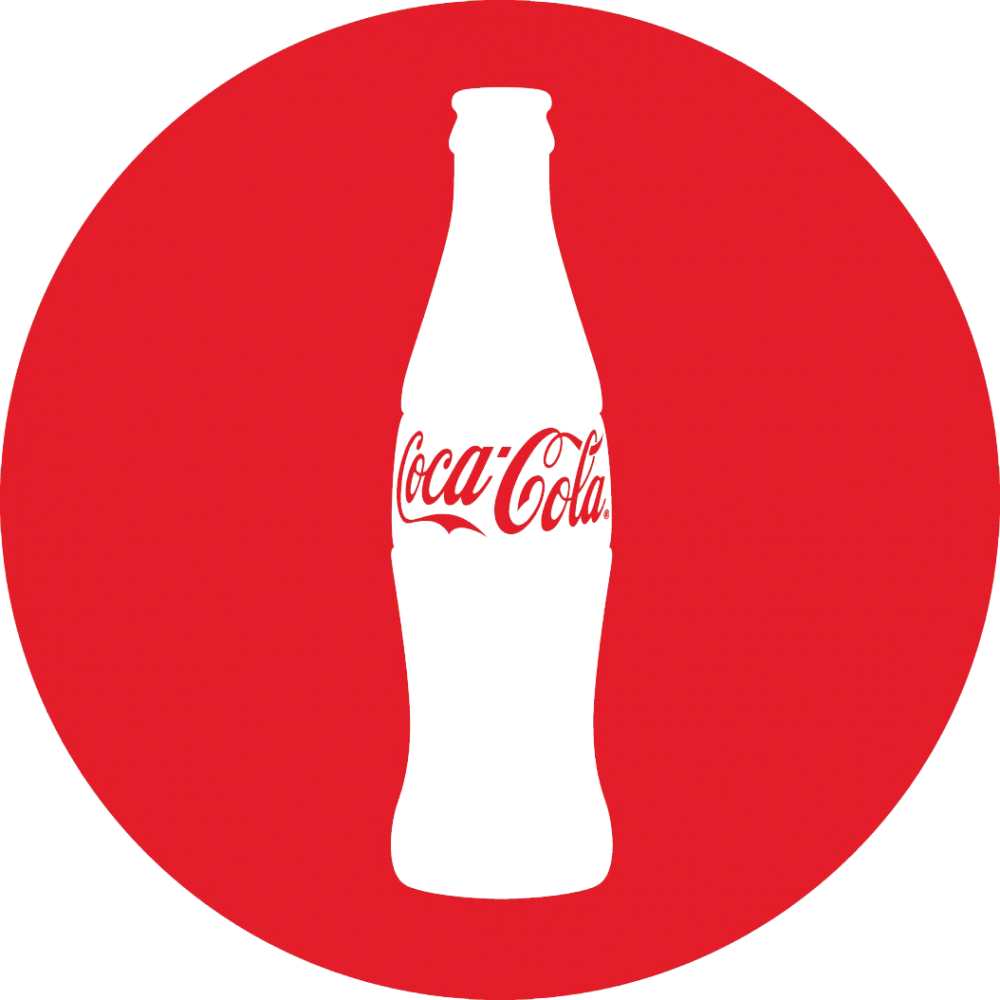


Agriculture and Ingredient Sourcing




The Coca Cola Company
Bottling Partners and Distributors
Consumers - Local Stores
Customers
Applications- Optimization
AMAZON'S SUPPLY CHAIN
Warehousing
Location
Size
Number of Warehouses
Delivery
Multiple Delivery Options
Technology
Robotic pick and pack
Introduction
WHAT ARE WE SOLVING?
Problem 1
We explore the challenge of allocating production demand across various facilities while minimizing the costs ensuring that the demand is met.
Problem 2
We design an optimal transportation route to improve operational efficiency while minimizing the distance.
Problem 1
BUSINESS DEFINITIONS
Problem
- Optimize supply chain network to meet regional demand at the lowest cost.
- Allocate production demand across various high and low capacity facilities for our client.
- Evaluate whether the facility should work on low or high capacity and whether the facility should be open or closed.
Problem 1
MIXED INTEGER PROGRAMMING
-
Mixed Integer Programming: Some of the values are restricted to integers whereas some can be continuous like in linear programming
-
Where is it used?: Solve problems with discrete choices
-
Methods used?: Branch and bound
Problem 1
DECISION VARIABLES
STANDARD FORM
PROBLEM STATEMENT
Problem 1
OBJECTIVE FUNCTION
STANDARD FORM
PROBLEM STATEMENT
Problem 1
CONSTRAINTS
STANDARD FORM
PROBLEM STATEMENT
Dataset
HEAD OF DIFFERENT DATASETS USED
Fixed Cost : 9 * 2 Matrix
Variable Cost: 9 * 9 Matrix
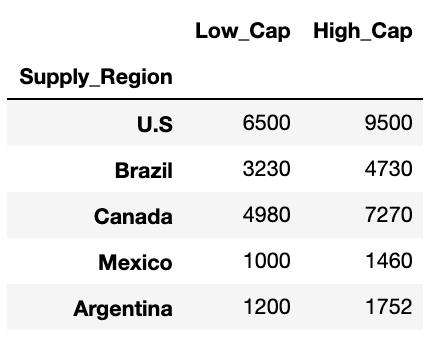
Demand : 9 * 1 Matrix
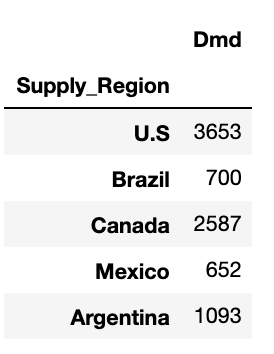
Plant Capacity : 9 * 2 Matrix
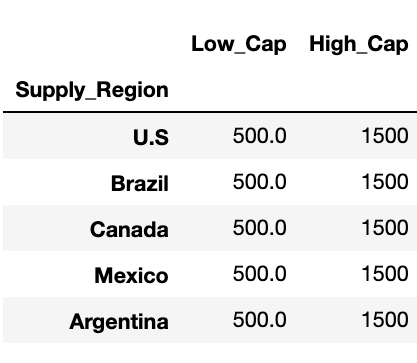

Code
Defining Decision Variables
from pulp import *
loc=list(demand.index)
size=['Low_Cap','High_Cap']
x=LpVariable.dicts("production_",
[(i,j) for i in loc for j in loc],
lowBound=0,upBound=None,
cat='Continuous')
y=LpVariable.dicts("plant_",
[(i,s) for i in loc for s in size],
cat='Binary')Python
Julia
using JuMP, GLPK
newModel = Model(GLPK.Optimizer)
@variable(newModel,
0 <= x[i=1:9,j=1:9])
@variable(newModel,
0 <= y[i=1:9,s=1:2] <= 1, Int) Code
Defining Objective Function
model +=
(lpSum([fix_cost.loc[i,s] * y[(i,s)]
for s in size for i in loc])
+ lpSum([var_cost.loc[i,j] * x[(i,j)]
for i in loc for j in loc]))Python
Julia
total_cost = 0
for i = 1:9
for j = 1:9
total_cost += var_cost[i,j] * x[i,j]
print("\nvar_cost\n", var_cost[i,j] * x[i,j])
end
for s = 1:2
total_cost += fix_cost[i,s] * y[i,s]
print("\nfix_cost\n", fix_cost[i,s] * y[i,s])
end
end
@objective(newModel, Min, total_cost)Code
Defining Constraints
for j in loc:
model +=
lpSum([x[i,j] for i in loc])
==
demand.loc[j,'Dmd']
for i in loc:
model +=
lpSum([x[(i, j)] for j in loc])
<= lpSum([cap.loc[i,s] * y[i,s]
for s in size])
for i in loc:
model +=
y[i,'High_Cap']+ y[i,'Low_Cap'] <= 1Python
Julia
for j = 1:9
@constraint(newModel,
sum(x[i,j] for i=1:9) == dmd[j])
for i = 1:9
@constraint(newModel, sum(x[i,j]
for j=1:9)
<= sum(cap[i, s] * y[i, s] for s=1:2))
end
for i = 1:9
@constraint(newModel, sum(y[i,s] for s=1:2) <= 1)
endResult
Optimized Solution - Y
Python
Julia
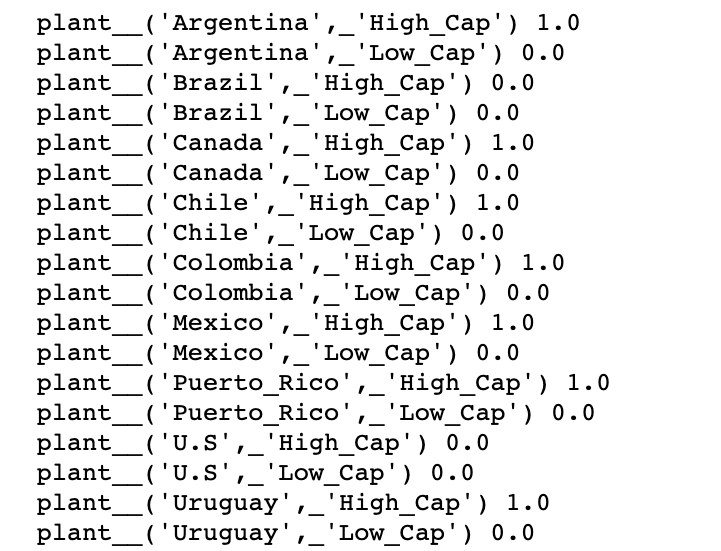

Result
Optimized Solution - x
Python
Julia
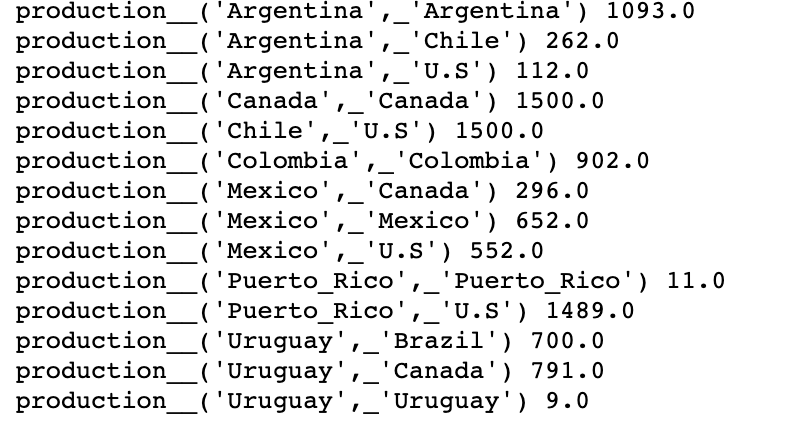

Code
Generating Maps
from geopy.geocoders import Nominatim
geolocator=Nominatim(user_agent="Optimization_Project")
a['Lat']=a['location'].apply(lambda x: geolocator.geocode(x).latitude)
a['Long']=a['location'].apply(lambda x: geolocator.geocode(x).longitude)
import folium
base_map2=folium.Map(location=[19.432630, -99.133178], zoom_start=2,tiles='cartodbpositron')
for idx, row in a.iterrows():
location=[row['Lat'],row['Long']]
if row['status']==1:
popup= '<strong>'+"OPEN"+"\n"+"\n"+row['capacity']+'</strong>'
marker=folium.Marker(location,popup=popup,icon=folium.Icon(color='green'))
else:
popup= '<strong>'+row['location']+'</strong>'
marker=folium.Marker(location,popup=popup,icon=folium.Icon(color='blue'))
marker.add_to(base_map2)Python
Result
Cost Reduction of 60 %
model_min=LpProblem("Capacitedplantlocation",LpMinimize)
model_max=LpProblem("Capacitedplantlocation",LpMaximize)
min_value=pulp.value(model_min.objective)
max_value=pulp.value(model_max.objective)
print("the improvement is: {} %".format(((max_value-min_value)/max_value)*100))
Problem 2
Problem
- Shift from operational level to supply & delivery
- Optimize delivery path to traverse all regions with demand at the shortest path.
BUSINESS DEFINITIONS
Problem 2
TRAVELING SALESMAN PROBLEM
-
Traveling Salesman Problem: Given a series of midpoints and their corresponding distance matrix, what is the shortest path that traverses all midpoints and go back to the origin?
-
Where is it used?: TSP is generally an NP problem, and the solution is widely used in operations and computer science.
-
Methods used?: many variants including Branch & Bound, DP. But at the end of the day, the complete solution of TSP would require enumerating certain possibilities that increase together with the number of nodes, so it is a Non-Deterministic Polynomial Problem.
Problem 2
OBJECTIVE FUNCTION
PROBLEM STATEMENT


Problem 1
DATA INPUT
GOOGLE GEOCODE API
GOOGLE DISTANCE MATRIX
DATA SOURCE
INPUT MATRIX

Dynamic Programming Solution
WALKING THROUGH DP SOLUTION
General Approach (Enumeration)
Dynamic Programming & Recursion
Time cost would be exponential
Introduce resource explosion
bottom-up approach: start from root; level up with either child node that has the minimum distance on its level


Web Demo
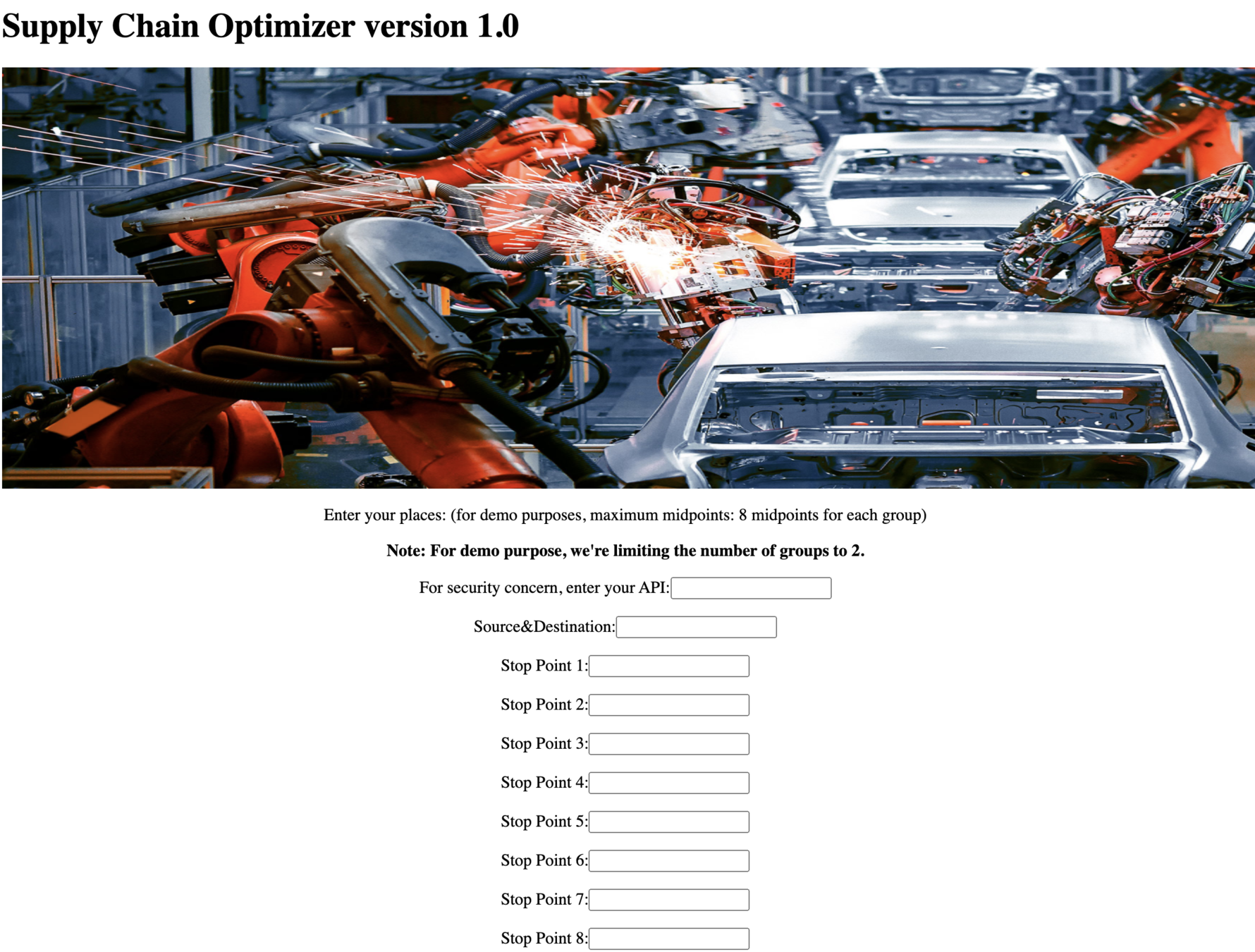

INTERACTIVE FEATURES FOR TSP SOLUTION IN SUPPLY CHAIN ANALYTICS
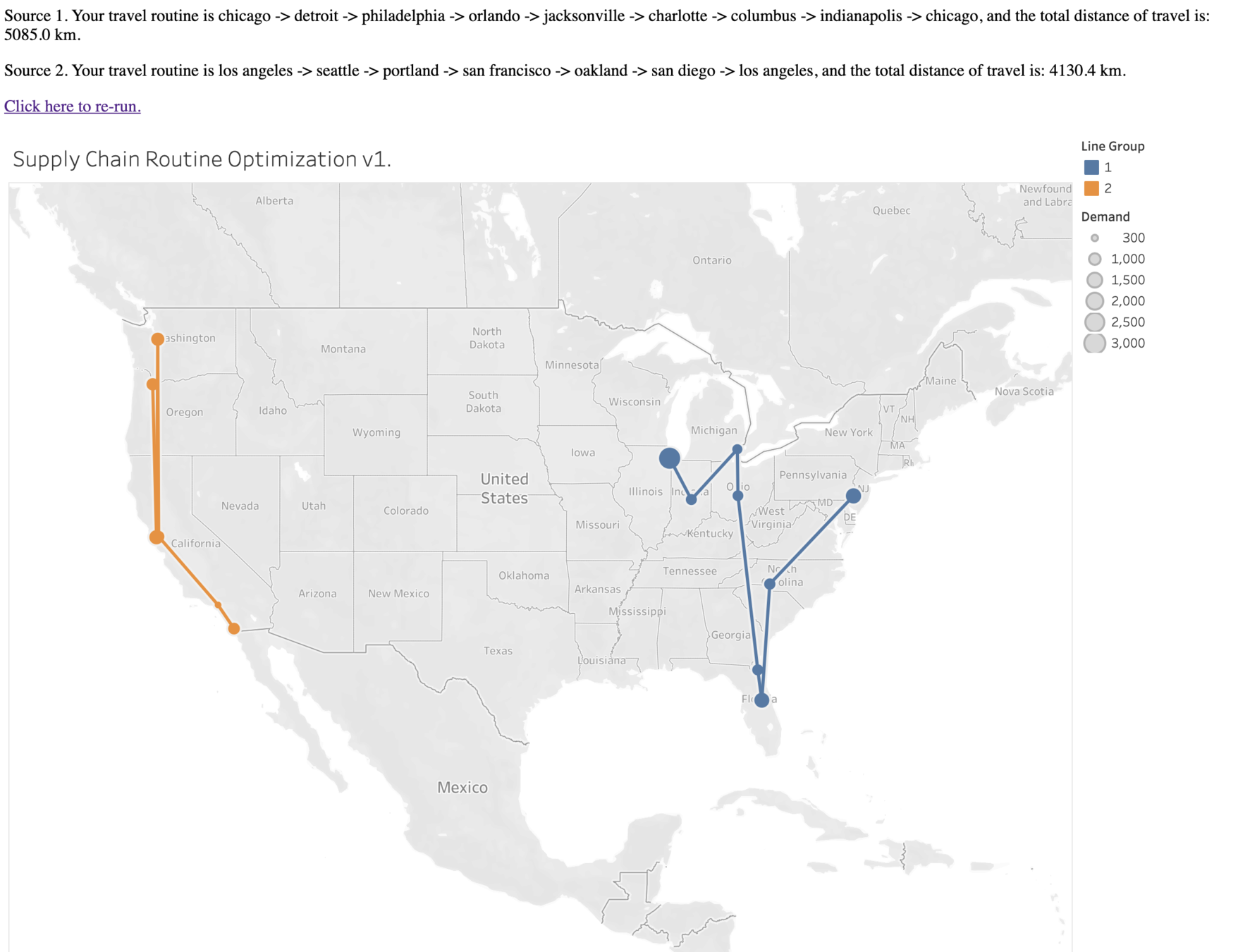
Web Demo
INTERACTIVE FEATURES FOR TSP SOLUTION IN SUPPLY CHAIN ANALYTICS
TSP - Simulated Annealing Algorithm
The method models the physical process of heating a material and then slowly lowering the temperature to decrease defects, thus minimizing the system energy.


TSP - Simulated Annealing Algorithm
The method models the physical process of heating a material and then slowly lowering the temperature to decrease defects, thus minimizing the system energy.
The algorithm is basically hill-climbing except instead of picking the best move, it picks a random move. If the selected move improves the solution, then it is always accepted. Otherwise, the algorithm makes the move anyway.
At time T, the probability of Energy change(dE) is expressed as:
P(dE) = exp( dE/(kT) )
The higher the temperature, the greater probability of Energy change.

Simulated Annealing Example




Temperature is decreased by 1000/(1+t)
Simulated Annealing in TSP
Step 1: Start with a random tour through the selected cities.
Step 2: Pick a new candidate tour at random from all neighbors of the existing tour.
Step 3:If the candidate tour is better than the existing tour, accept it as the new tour.
Step 4:If the candidate tour is worse than the existing tour, still maybe accept it, according to some probability. The probability of accepting an inferior tour is a function of how much longer the candidate is compared to the current tour, and the temperature of the annealing process.
Step 5: Go back to step 2 and repeat many times, lowering the temperature a bit at each iteration, until you get to a low temperature and arrive at your (hopefully global, possibly local) minimum


Thank You!
Optimzation-Final-Project
By Devanshi Verma
Optimzation-Final-Project
- 1,118

